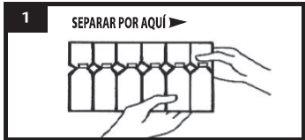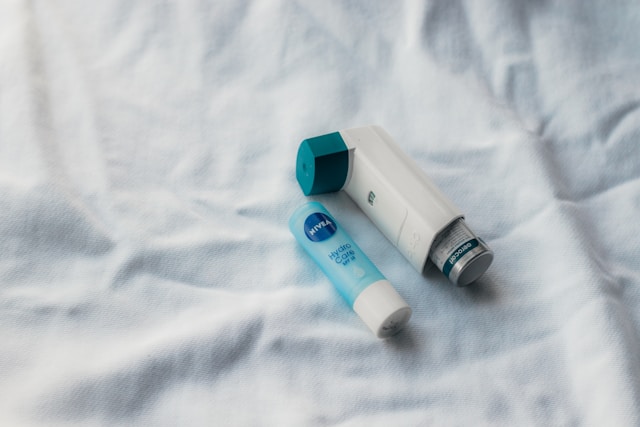

BUDENA 0.5 mg/ml SUSPENSION FOR NEBULIZER INHALATION

Ask a doctor about a prescription for BUDENA 0.5 mg/ml SUSPENSION FOR NEBULIZER INHALATION

How to use BUDENA 0.5 mg/ml SUSPENSION FOR NEBULIZER INHALATION
Introduction
Package Leaflet: Information for the User
Budena 0.5 mg/ml suspension for inhalation by nebulizer
Budesonide
Read this package leaflet carefully before you start taking this medicine, because it contains important information for you.
- Keep this package leaflet, you may need to read it again.
- If you have any further questions, ask your doctor or pharmacist.
- This medicine has been prescribed for you only. Do not pass it on to others. It may harm them, even if their symptoms are the same as yours.
- If you experience any side effects, talk to your doctor or pharmacist. This includes any possible side effects not listed in this package leaflet. See section 4.
Contents of the package leaflet
- What is Budena and what is it used for
- What you need to know before taking Budena
- How to take Budena
- Possible side effects
- Storage of Budena
- Package contents and further information
1. What is Budena and what is it used for
Budena 0.5 mg/ml is a sterile suspension for inhalation via a nebulizer (inhalation device). When you breathe through the mouthpiece or mask, the medicine will reach your lungs through the inhaled air.
Budena contains budesonide. Budesonide belongs to a group of medicines called glucocorticoids, which are used to reduce inflammation.
Asthma is caused by inflammation of the airways. Budesonide reduces and prevents this inflammation.
Budena is used for the maintenance treatment of asthma and the treatment of very severe subglottic laryngitis that requires hospitalization. It should be used regularly as directed by your doctor.
2. What you need to know before taking Budena
Do not use Budena:
If you are allergic to budesonide or any of the other ingredients of this medicine (listed in section 6).
Warnings and precautions
Talk to your doctor or pharmacist before starting to take budesonide if any of the following apply to you:
- If you have or have had pulmonary tuberculosis or any other recent infection.
- If you have ever had liver problems.
- If your doctor has prescribed budesonide for you and you are being treated with corticosteroid tablets, your doctor may gradually reduce the dose of these tablets (over a period of weeks or months) and may eventually stop the previous treatment. In this case, some symptoms such as runny nose, hives, or muscle and joint pain may temporarily reappear. If any of these symptoms worry you, or if you experience any other symptoms such as headache, fatigue, nausea, or vomiting, contact your doctor.
- Budesonide has been prescribed for you for the maintenance treatment of asthma. However, it will NOT relieve an acute asthma attack once it has started.
- Contact your doctor if you experience blurred vision or other visual disturbances.
Children
- If administered to children, your doctor will regularly review their growth, as this medicine may cause growth retardation.
Talk to your doctor if you have any other health problems. Do not use this medicine for other conditions without your doctor's advice. Never give it to another person.
Not all nebulizers are suitable for use with budesonide. DO NOTuse ultrasonic nebulizers with Budena 0.5 mg/ml suspension for inhalation by nebulizer.
Using Budena with other medicines:
Tell your doctor or pharmacist if you are using, have recently used, or might use any other medicines. This includes medicines obtained without a prescription and herbal remedies. Some medicines may increase the effects of budesonide, so your doctor will monitor you closely if you are taking these medicines. In particular, tell your doctor or pharmacist if you are using any of the following medicines:
- Medicines for treating fungal infections (such as itraconazole and ketoconazole).
- Medicines for HIV (such as ritonavir or cobicistat).
- Cimetidine (a medicine for stomach acidity).
- Estrogens and steroid contraceptives.
Use in athletes
Athletes are informed that this medicine contains a component that may produce a positive result in doping tests.
Pregnancy and breastfeeding
If you are pregnant or breastfeeding, think you may be pregnant, or plan to become pregnant, consult your doctor or pharmacist before using this medicine.
There is no evidence that budesonide can harm the mother or child during pregnancy or breastfeeding. However, you should contact your doctor as soon as possible if you become pregnant during treatment with budesonide.
Budesonide passes into breast milk, but in minimal amounts that do not affect the baby.
Use in children
Budesonide should always be administered under adult supervision to ensure correct administration of the medicine.
Driving and using machines
The influence of inhaled budesonide on the ability to drive and use machines is negligible.
3. How to take Budena
Follow your doctor's instructions for taking the medicine exactly. If you are unsure, consult your doctor or pharmacist again.
Method of use and administration route
Budesonide should only be used for inhalation via a nebulizer. Do not use ultrasonic nebulizers, as they are not suitable for administering this medicine. Before starting treatment, you should know how to use the nebulizer. It is essential that you read the information in the "How to use Budena" section and follow the instructions carefully.
Dosage, administration frequency, and treatment duration
The dose of budesonide should be individualized. Your doctor will adjust the dose and prescribe the minimum dose that controls your asthma or subglottic laryngitis symptoms. Follow your doctor's instructions carefully.
Your doctor will indicate the duration of your treatment with budesonide. Do not stop treatment before this, as your condition may worsen severely. Do not take more doses than your doctor has indicated.
If you think the effect of budesonide is too strong or too weak, tell your doctor or pharmacist.
Asthma
Recommended initial dose:
Children from 6 months onwards: 0.25-1 mg per day. In very severe cases, or in children treated with corticosteroid tablets, a higher initial dose (up to 2 mg per day, equivalent to 2 ampoules) may be administered. Your doctor may then consider adjusting the dose. Daily doses of up to 1 mg (1 ampoule) can be administered as a single dose. In cases where the lowest dose (0.25 mg/day) is needed, 1 ml of budesonide 0.25 mg/ml suspension for inhalation by nebulizer should be used.
Adults and elderly: 1-2 mg per day (1-2 ampoules per day). In very severe cases, the dose can be increased up to 4 mg (4 ampoules). Your doctor may then consider adjusting the dose. Daily doses of up to 1 mg (1 ampoule) can be administered as a single dose.
Maintenance dose: When your symptoms have improved, your doctor may decide to reduce your dose to the minimum dose that keeps you symptom-free.
It is possible that budesonide will provide relief from symptoms within a few days of treatment, although it may take 2-4 weeks to achieve a full effect. Therefore, it is essential that you do not stop using budesonide even when you feel better.
Remember that budesonide has been prescribed for you for the maintenance treatment of asthma. However, it will NOTrelieve an acute asthma attack once it has started.
Subglottic laryngitis
Infants and children: 2 mg per day (equivalent to 2 ampoules). This can be administered in a single dose or in two doses of 1 mg, separated by a 30-minute interval. The administration can be repeated every 12 hours for a maximum of 36 hours or until your doctor considers that your symptoms have improved.
How to use Budena 0.5 mg/ml suspension for inhalation by nebulizer
|
|
| |
| |
|
- Gently shake the reservoir again and start the nebulization. During nebulization, breathe in the mist of the nebulized suspension deeply and slowly.
- When no more mist comes out of the mouthpiece or mask, the treatment is finished.
- When you have finished, rinse your mouth with water (do not swallow the water) and brush your teeth. If you have used a mask, wash your face well. It is essential to do this to reduce the risk of some side effects associated with this medicine.
- After each use, wash the nebulizer thoroughly. Wash the nebulizer reservoir and mouthpiece or mask with warm water using a mild detergent, following the manufacturer's instructions. The nebulizer should be rinsed well and dried by connecting the reservoir to the compressor or air outlet.
It is essential that you always follow the manufacturer's instructions that come with the nebulizer. If you are unsure about how to use the nebulizer, consult your doctor or pharmacist.
If you use more Budenathan you should
If you use a higher dose of budesonide than you should in a single occasion, it is unlikely to cause harm. If you use too much budesonide over a long period (months), side effects may occur. In this case, consult your doctor or pharmacist immediately.
If you have used more budesonide than you should, consult your doctor, pharmacist, or call the Toxicology Information Service, telephone 91 562 04 20, indicating the medicine and the amount used. It is recommended to take the package and package leaflet of the medicine to the healthcare professional.
It is essential that you use the dose indicated on the packaging (space reserved for the pharmacist) or the dose prescribed by your doctor. Do not increase or decrease your dose without consulting your doctor.
If you forget to use Budena
If you forget to use a dose of budesonide, do not use a double dose to make up for the missed doses. Continue with your usual treatment as prescribed by your doctor.
If you have any doubts about using this medicine, ask your doctor or pharmacist.
4. Possible side effects
Like all medicines, this medicine can cause side effects, although not everybody gets them. Usually, no side effects occur during the use of budesonide. However, tell your doctor about the following side effects that bother you or do not go away:
Common side effects: May affect up to 1 in 10 people
- Mild throat irritation.
- Cough.
- Hoarseness
- Fungal infection of the mouth and throat.
Uncommon side effects: May affect up to 1 in 100 people
- Cataracts (loss of transparency of the lens in the eye).
- Anxiety.
- Depression.
- Tremors.
- Muscle cramps.
- Blurred vision.
Rare side effects: May affect up to 1 in 1000 people
- Allergic reactions, including skin rash, contact dermatitis, hives, and angioedema (swelling of the face, lips, and/or tongue with difficulty swallowing and breathing).
- Bruises on the skin.
- Behavioral changes (especially in children).
- Restlessness.
- Nervousness.
- As with other inhaled treatments, bronchospasm (i.e., contraction of the airways, which causes wheezing) may rarely occur.
- Effects on the adrenal glands (small glands located next to the kidneys).
- Growth retardation.
Side effects of unknown frequencywhich may include
- Sleep disorders, hyperactivity, or aggression.
- Glaucoma (increased eye pressure).
Corticosteroids inhaled may affect the normal production of steroid hormones in the body, especially if high doses are used for a long time. These effects include:
- changes in bone mineral density (decrease in bone mass).
These effects are much less likely with inhaled corticosteroids than with corticosteroid tablets.
If you were previously treated with corticosteroid tablets, switching to inhaled corticosteroids may cause some symptoms such as fatigue, abdominal pain, weakness, or vomiting to reappear. If you experience any of these symptoms, contact your doctor immediately.
In rare cases, long-term treatment with high doses may cause a reduction in growth rate in children, mainly in patients previously treated with corticosteroid tablets or particularly sensitive.
Skin irritation on the face has been observed in some cases where a nebulizer with a facial mask has been used. To prevent facial irritation, the face should be washed with water after using the mask.
If you think any of the side effects you are experiencing is serious, or if you notice any side effects not mentioned in this package leaflet, tell your doctor or pharmacist.
Reporting side effects
If you experience any side effects, talk to your doctor or pharmacist. This includes any possible side effects not listed in this package leaflet. You can also report side effects directly through the Spanish Pharmacovigilance System for Human Use Medicines: www.notificaRAM.es. By reporting side effects, you can help provide more information on the safety of this medicine.
5. Storage of Budena
Keep this medicine out of the sight and reach of children.
Do not use this medicine after the expiry date stated on the carton or package after EXP. The expiry date is the last day of the month stated.
Store the ampoules in the original package and in the package, protected from light.
Once an ampoule is opened, it must be used within 24 hours. After this time, any unused amount must be discarded.
Once the package is opened, the ampoules must be used within 3 months (it is recommended to note the opening date on the package to help you remember it)
Medicines should not be disposed of via wastewater or household waste. Place the packages and medicines you no longer need in the SIGRE collection point at your usual pharmacy or any other medicine waste collection system. If in doubt, ask your pharmacist how to dispose of packages and medicines you no longer need. This will help protect the environment.
6. Package contents and further information
Composition of Budena
The active ingredient of Budena 0.5 mg/ml suspension for inhalation by nebulizer is budesonide. Each sterile ampoule of 2 ml contains 1 mg of budesonide. The other ingredients (excipients) are: disodium edetate, sodium chloride, polysorbate 80, anhydrous citric acid, sodium citrate, and water for injectable preparations.
Appearance of the product and package contents
Budena is presented in low-density polyethylene ampoules with 2 ml of white or off-white suspension to be nebulized (converted into a fine mist for inhalation).
The ampoules are packaged in strips of 5 ampoules in an aluminum package, which is packaged in cardboard boxes. There are packages containing 20 ampoules.
Marketing Authorization Holder:
Laboratorio Aldo-Unión, S.L.
Baronesa de Maldá, 73
08950 Esplugues de Llobregat, Barcelona
Spain
Manufacturer:
Genetic S.p.A.
Nucleo Industriale, Contrada Canfora, 84084 Fisciano (SA)
Italy
Date of last revision of this package leaflet:June 2020
Detailed and updated information on this medicine is available on the website of the Spanish Agency for Medicines and Health Products (AEMPS) http://www.aemps.gob.es/

How much does BUDENA 0.5 mg/ml SUSPENSION FOR NEBULIZER INHALATION cost in Spain ( 2025)?
The average price of BUDENA 0.5 mg/ml SUSPENSION FOR NEBULIZER INHALATION in December, 2025 is around 12 EUR. Prices may vary depending on the region, pharmacy, and whether a prescription is required. Always check with a local pharmacy or online source for the most accurate information.
- Country of registration
- Average pharmacy price12 EUR
- Active substance
- Prescription requiredYes
- Manufacturer
- This information is for reference only and does not constitute medical advice. Always consult a licensed doctor before taking any medication. Oladoctor is not responsible for medical decisions based on this content.
- Alternatives to BUDENA 0.5 mg/ml SUSPENSION FOR NEBULIZER INHALATIONDosage form: PULMONARY INHALATION, 0.25 mg/mlActive substance: budesonideManufacturer: Laboratorio Aldo Union S.L.Prescription requiredDosage form: PULMONARY INHALATION, 0.04000 gActive substance: budesonideManufacturer: Laboratorio Aldo Union S.L.Prescription requiredDosage form: PULMONARY INHALATION, 0.25 mg budesonide/mlActive substance: budesonideManufacturer: Laboratorio Aldo Union S.L.Prescription required
Alternatives to BUDENA 0.5 mg/ml SUSPENSION FOR NEBULIZER INHALATION in other countries
The best alternatives with the same active ingredient and therapeutic effect.
Alternative to BUDENA 0.5 mg/ml SUSPENSION FOR NEBULIZER INHALATION in Polónia
Alternative to BUDENA 0.5 mg/ml SUSPENSION FOR NEBULIZER INHALATION in Ukraine
Online doctors for BUDENA 0.5 mg/ml SUSPENSION FOR NEBULIZER INHALATION
Discuss dosage, side effects, interactions, contraindications, and prescription renewal for BUDENA 0.5 mg/ml SUSPENSION FOR NEBULIZER INHALATION – subject to medical assessment and local rules.

















